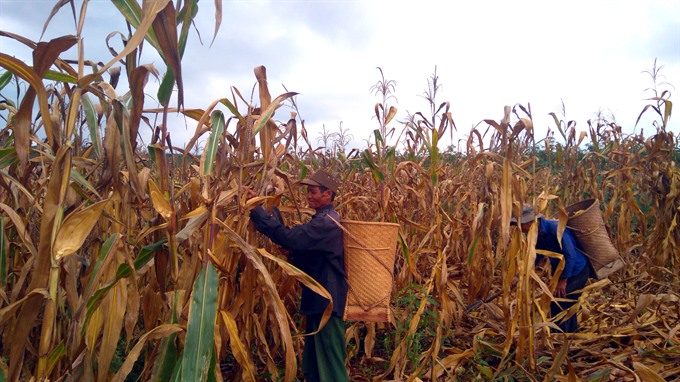 Society
Society

“Almost all farmers face difficulties getting bank loans as they struggle to put a security up for loans,” said Nguyễn Đăng Cường, a farmer in Thuận Thành District, northern Bắc Ninh Province.
 |
| Farmers in Đăk Smar Commune in the Central Highland’s province of Gia Lai, harvest maize. Farming households, especially those in remote areas, found it difficult to get bank loans because they had no mortages, thus they were struggling to escape the cycle of poverty. — VNA/VNS Photo Hoài Nam |
HÀ NỘI — “Almost all farmers face difficulties getting bank loans as they struggle to put a security up for loans,” said Nguyễn Đăng Cường, a farmer in Thuận Thành District, northern Bắc Ninh Province.
Cường, a farmer in the province with 42ha of rice, fishing and duck farming land, told Tin tức (News) newspaper that borrowing money from banks to expand his business was difficult despite preferential Government policies for farmers.
Government Decree 55/2015/NĐ-CP, effective from July 2015, offered preferential loans to farmers with amounts up to VNĐ2 billion (US$90,000), but few could access the loans, he said.
“Borrowers must have real estate as a collateral for the loan. Banks offer loans equal to 70 per cent of the real estate value and for only six months,” Cường said.
At least VNĐ1 billion ($45,000) is needed for one hectare of land to generate high profit products extensively. If using high technology, the cash needed could increase to between VNĐ6 billion ($269,000) – VNĐ10 billion ($450,000) per hectare, he said.
However, Cường is much luckier than other farmers, particularly those who don’t have anything to put up to secure loans. Without mortgages, they can’t access bank loans. Consequently, they often take out ‘black credit’ loans on the black market.
These loans usually have high interest rates and push farmers into deeper debt. Many can only afford to pay the monthly interest.
Last month, Nông thôn ngày nay (Countryside Today) newspaper reported hundreds of families in Ia Pa District, in the Central Highland province of Gia Lai, were struggling with debts they borrowed at high interest rates.
Rcom Nhơk, a woman in the district’s Ia Broai Commune said she paid interest of almost VNĐ3 million monthly after borrowing VNĐ43 million to build a house and another VNĐ35 million ($1,500) for farm land.
“My husband and I earn about VNĐ300,000–VNĐ400,000 daily, just enough to feed our family and pay the interest of our loans,” she said.
Kpa Tin, a resident of the same commune, said in 2013 his family borrowed VNĐ30 million but after interest he now owed VNĐ66 million.
He said that he considered selling his house to pay the debt.
According to Ia Pa District People’s Committee, black credit is reported in eight out of nine communes in the district with total debts of VNĐ76 billion ($3.4 million) while the original loans were only worth about VNĐ18 billion. Nearly 700 families were in debt.
Local residents usually borrowed money for health care, buying fertiliser or building houses. They paid interest of VNĐ30,000–VNĐ60,000 per month for every VNĐ1 million they borrowed.
Inadequate credit policy
At a conference late last month on credit policy for agriculture and rural development, experts blamed inadequate Government agriculture credit policies for farmers’ lack of access to bank loans.
Lê Đức Thịnh, deputy director of the Rural Development and Economic Co-operative Department under the Ministry of Agriculture and Rural Development said farming households, especially those in remote areas, found it difficult to get bank loans because they didn’t have mortgages, leaving them stuck in poverty.
Last year, just 0.67 per cent of 11,000 agriculture co-operatives borrowed loans from banks.
Nguyễn Đức Thành, director of the Việt Nam Institute for Economic and Policy Research (VEPR), said that in addition to mortgage requirements, banks offered loans with fixed terms of six months, 12 months, 24 months or 36 months which did not match agriculture production cycles.
“Simplifying credit procedures and conditions are crucial for farmers and agriculture businesses to better access loans,” he said.
Instead of requiring land-use certificates as mortgages for the loans, banks should consider other conditions, for examples assets on the land, products generated from the loans, investment project proposals, co-operation partnership agreements or insurance contracts, experts said. — VNS




